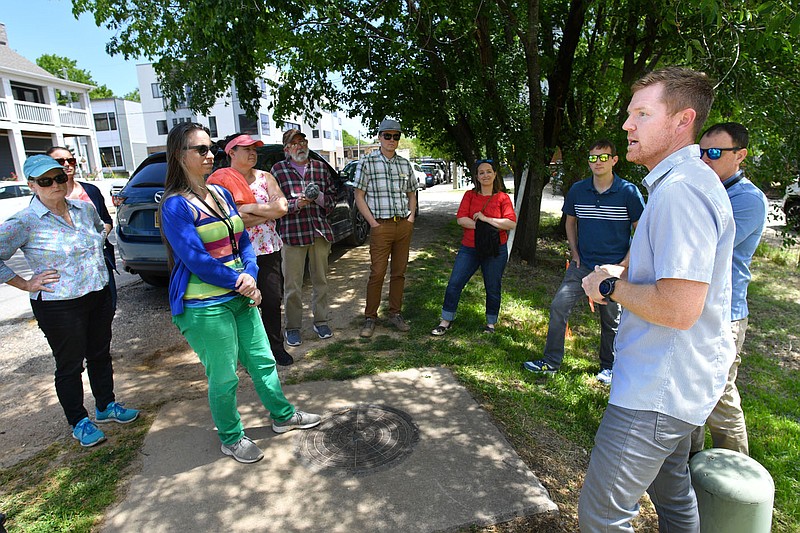SPRINGDALE — Regional planners are joining others in rejecting the century-old notion that traffic crashes are accidents, events no one can fully predict or prevent.
Vision Zero is, at heart, a traffic safety philosophy that lays out a set of principles and elements for engineering roads, educating travelers and creating a sense of collective responsibility among fellow travelers, according to Elizabeth Bowen, senior planner and project manager at the Northwest Arkansas Regional Planning Commission.
First implemented in Sweden in the 1990s, Vision Zero proved successful across Europe and began spreading to the United States a decade later. It’s gaining momentum in American cities with help from the U.S. Department of Transportation, state, regional and local planning and transportation agencies.
More than 45 communities have committed to Vision Zero in the U.S. while many others are considering and working toward such a commitment, according to the Vision Zero Network. None of those listed are in Arkansas.
The Vision Zero Network is a nonprofit project that brings leaders in transportation planning, engineering, policymaking, public health, community advocacy, research and the private sector together to develop and share promising strategies and advocate for Vision Zero nationally.
“It is a requirement to have a Vision Zero plan in order to apply for several of the federal grants,” Bowen said.
The Arkansas Department of Transportation’s plan, Toward Zero Deaths, has programs aimed at curbing impaired and distracted driving, encouraging seat belt use, work zone safety, rail crossing safety, motorcycle safety, bike and pedestrian safety and move over laws as well as speed enforcement.
REDUCING THE DANGER
More than 42,000 people are killed on U.S. roads and thousands more are injured nationwide each year. Statewide, 644 people died in traffic crashes on Arkansas roads in 2022, according to the state department.
In 2021, 55 people died on Northwest Arkansas roads, according to Bowen. The average annual number of traffic fatalities in Northwest Arkansas between 2017 and 2021 was 43, according to the Arkansas Crash Analytics Tool.
The Northwest Arkansas Regional Vision Zero Plan is a part of the national Safer Streets and Roads for All program. It begins with a simple idea that traffic deaths and severe injuries are preventable among all road users, whether walking, biking, riding scooters, driving or riding transit, Bowen said.
The approach prioritizes safety for people, focusing on designing roads and vehicles and setting speeds and related policies in ways that prevent the inevitable human mistakes from causing severe injuries or fatalities.
“We understand there are going to be crashes, but we want them to be at a level that will not be detrimental to an individual,” she said.
The approach includes specific transportation system design principles.
“For trail design, as an example, we can use different types of crossings mechanisms; the HAWK system is a leading interval technology that can be utilized to give a person that’s walking across that five-lane road more time to get across. They would start before the traffic lights would change, for example,” Bowen said.
For motorized vehicles, measures include roundabouts, raised medians and access management — not having so many curb cuts so people don’t have that constant braking interaction, she said.
Roads can also be designed and constructed to increase safety. In more rural areas, that may include designs for roadsides that reduce the number of obstacles cars would strike if they ran off the road, pavements that reduce skidding and increased use of rumble strips, crash cushions, guardrails and median cable barriers.
In more urban areas, it may include designs for urban intersections that reduce the speed of turning cars, the broad use of roundabouts to bring down vehicle speeds in intersections and shorter pedestrian crossing distances that make it safer and easier for people to cross streets.
While preventing crashes is the highest priority, improving post-crash emergency responses and trauma care can also save lives.
CITIES EXAMINE ROAD CONCERNS
While individual communities have been working to make roads safer, a coordinated effort is needed to address the issues that cause the collisions, Bowen said. The Northwest Arkansas Regional Vision Zero Plan is being developed as part of a regional effort. The plan will lay out recommendations for projects, policies and programs.
The regional plan will allow the area to apply for federal grants, Bowen said.
Dennis Birge, transportation director in Bentonville, said the city is still looking into all that is required to apply for the grants, but it’s interested in applying for a project on Greenhouse Road.
Still in the early design phase, the idea is to add lanes as well as sidewalk and a trail system and improve crosswalks at the intersections of Greenhouse and Arkansas 102 and Greenhouse and Arkansas 112. They’re also considering a trail crossing below grade of the driving lanes with the addition of a possible tunnel or bridge structure.
“This project should touch on most of the Vision Zero implementation practices and hopefully make for a good candidate for the implementation grants of 2023,” Birge said. “This roadway carries 14,000 average daily traffic as of 2022 counts and connects two arterial sections that carry approximately 30,000 average daily traffic each.”
Fayetteville has several projects they may submit for grant consideration, according to Chris Brown, public works director. Those include a separated bike path along Maple Street between Gregg and Garland avenues and pedestrian safety improvements along College Avenue, like sidewalks, signals and raised medians in certain areas north of Sycamore Street.
The city is also looking at ways to prevent rear-end collisions on Joyce Boulevard, which could entail adding a turn lane or roundabouts and medians.
“It’s a pretty good bucket of money, so I think we’ve got a pretty good chance of getting some funding for these projects,” Brown said. “All of these are projects that we had either in design or in our bond program, so it just kind of helps supplement our bond funding for these projects.”
Up the road, Springdale has several streets — including Pleasant, Thompson and an area that includes Johnson, Meadow, Main, Blair and Commercial — that it’s considering for safe street or Vision Zero projects, according to Ryan Carr, deputy director of engineering. The projects would include narrowing lanes, installing bike lanes and making sidewalk/side path connections through intersections.
Regional Planning staff and their consultant, Toole Design Group, along with stakeholders toured two demonstration projects recently, one in Bentonville and another in Fayetteville on Wednesday. The Fayetteville session looked at trail crossings on West Prairie Street, Martin Luther King Jr. Boulevard and South School Street. The Bentonville session looked at bike and pedestrian facilities along Southwest Eighth Street. The idea is to reduce conflict between cars and cyclists and pedestrians.
INPUT WANTED
The draft NWA Regional Vision Zero Plan is on the Northwest Arkansas Regional Planning Commission website. Public input is requested. Planners hope to approve the plan by the end of June so local projects can be submitted for grant consideration.
“We need input from the communities that comprise Northwest Arkansas. Crash history only tells us part of the story,” Bowen said. “To really understand where safety is an issue, we need citizens to tell us about locations they feel are unsafe, even if a crash has never occurred there.”
In January 2022, U.S. Transportation Secretary Pete Buttigieg announced the goal of Vision Zero for the nation and released the first National Roadway Safety Strategy.
“We cannot and must not accept that these fatalities are somehow an inevitable part of life in America,” Buttigieg said. “When it comes to roadway deaths, we have a crisis that’s urgent, unacceptable — and preventable.”
Road to Zero
The Northwest Arkansas Regional Planning Commission is asking for citizens throughout the region to get involved in the development of the Northwest Arkansas Regional Vision Zero Plan by reviewing the project website, watching videos and taking an online survey at https://www.nwarpc.org/transportation/vision-zero-plan.
The survey will be available until May 19.
Source: Northwest Arkansas Regional Planning Commission
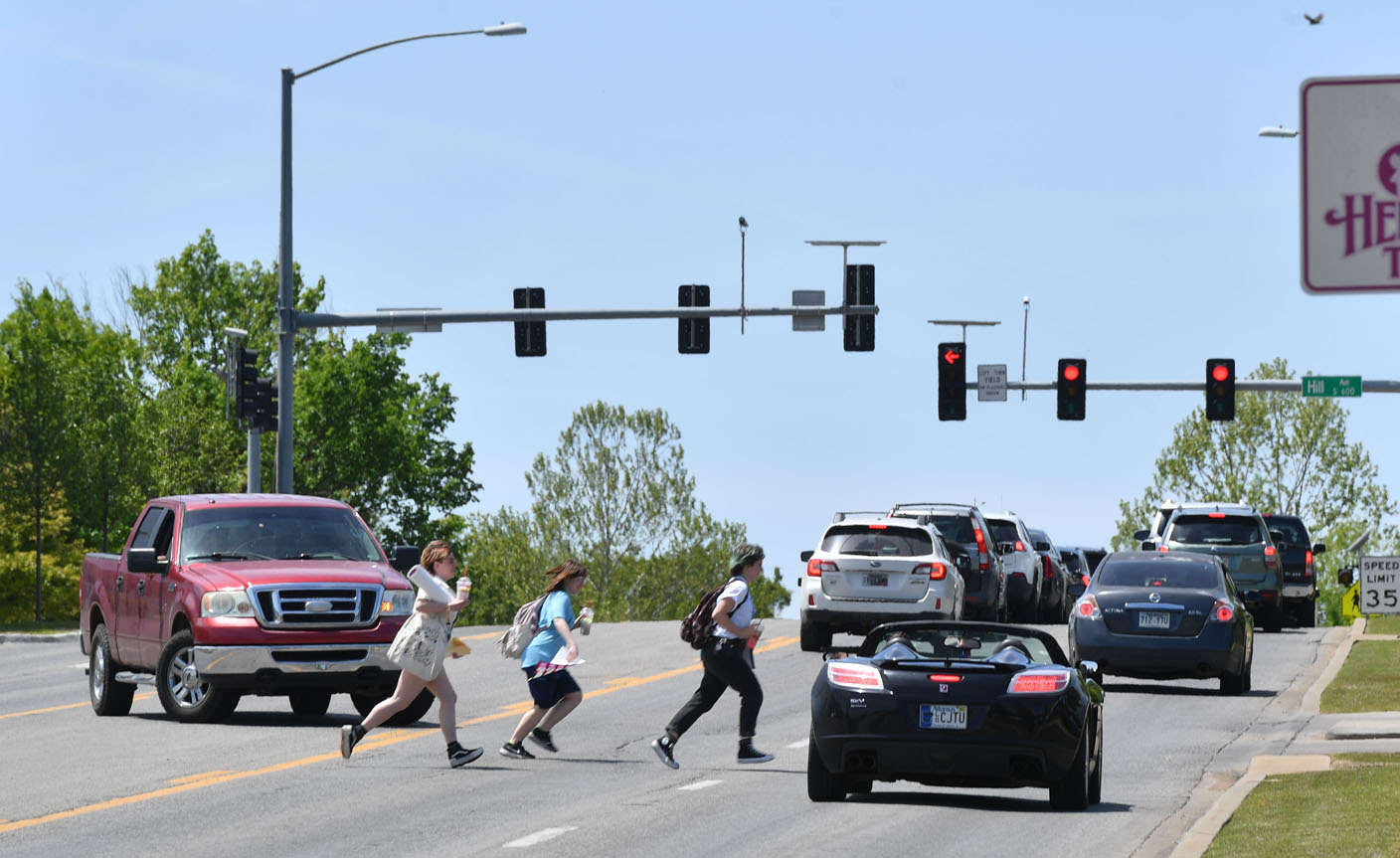 Pedestrians cross Wednesday, May 3, 2023, through traffic to the north side of Martin Luther King Jr. Boulevard in south Fayetteville. Toole Design Group is assisting the Northwest Arkansas Regional Vision Zero Plan with its strategy to prevent traffic deaths through the implementation of infrastructure changes following a study of the area. Visit nwaonline.com/photo for today's photo gallery. (NWA Democrat-Gazette/Andy Shupe)
Pedestrians cross Wednesday, May 3, 2023, through traffic to the north side of Martin Luther King Jr. Boulevard in south Fayetteville. Toole Design Group is assisting the Northwest Arkansas Regional Vision Zero Plan with its strategy to prevent traffic deaths through the implementation of infrastructure changes following a study of the area. Visit nwaonline.com/photo for today's photo gallery. (NWA Democrat-Gazette/Andy Shupe)
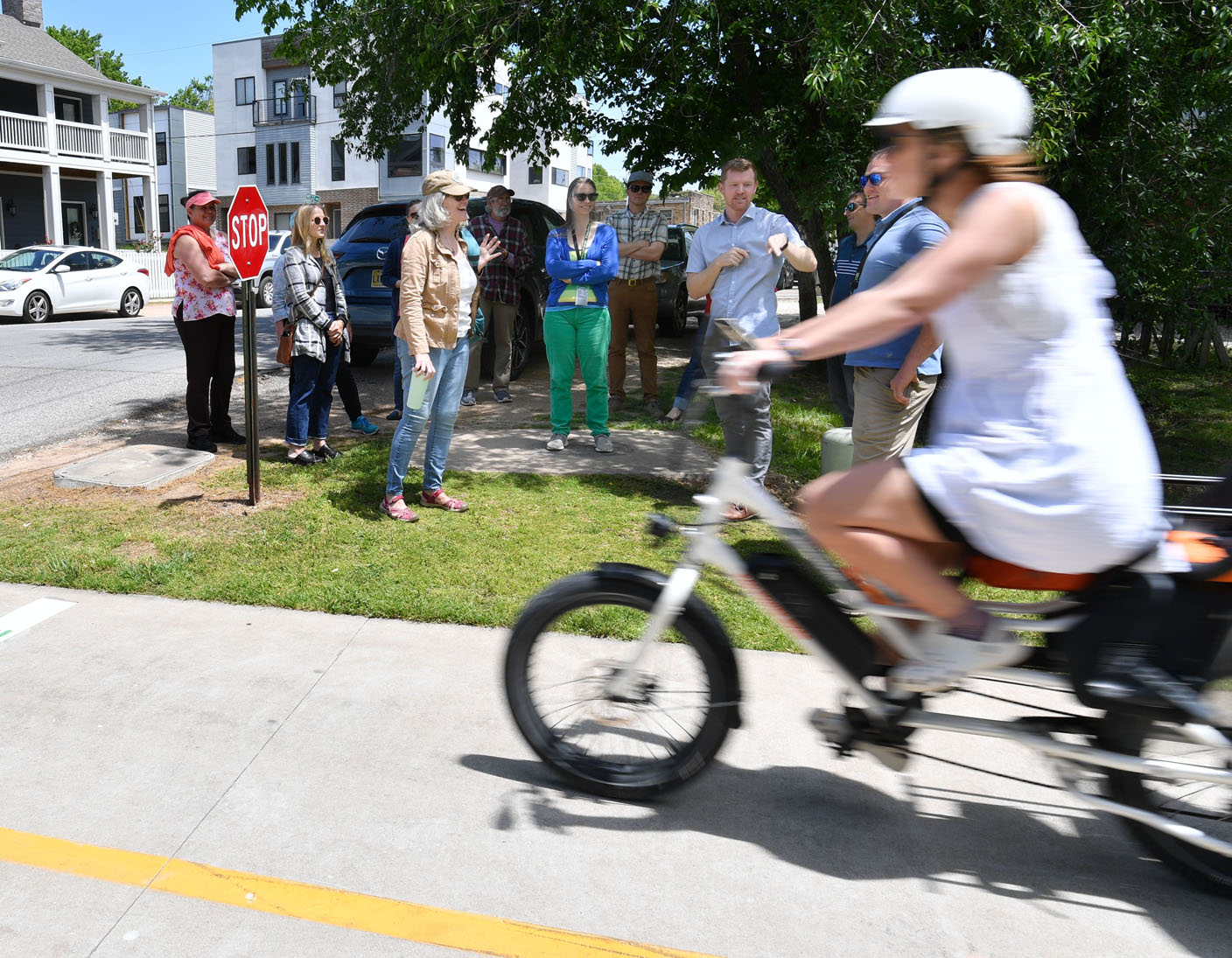 A resident on a bicycle rides past Wednesday, May 3, 2023, as a group of city staff and stake holders watch at the intersection of the Razorback Greenway and Prairie Street during a tour of infrastructure around Martin Luther King Jr. Boulevard and School Avenue in south Fayetteville. Toole Design Group is assisting the Northwest Arkansas Regional Vision Zero Plan with its strategy to prevent traffic deaths through the implementation of infrastructure changes following a study of the area. Visit nwaonline.com/photo for today's photo gallery. (NWA Democrat-Gazette/Andy Shupe)
A resident on a bicycle rides past Wednesday, May 3, 2023, as a group of city staff and stake holders watch at the intersection of the Razorback Greenway and Prairie Street during a tour of infrastructure around Martin Luther King Jr. Boulevard and School Avenue in south Fayetteville. Toole Design Group is assisting the Northwest Arkansas Regional Vision Zero Plan with its strategy to prevent traffic deaths through the implementation of infrastructure changes following a study of the area. Visit nwaonline.com/photo for today's photo gallery. (NWA Democrat-Gazette/Andy Shupe)
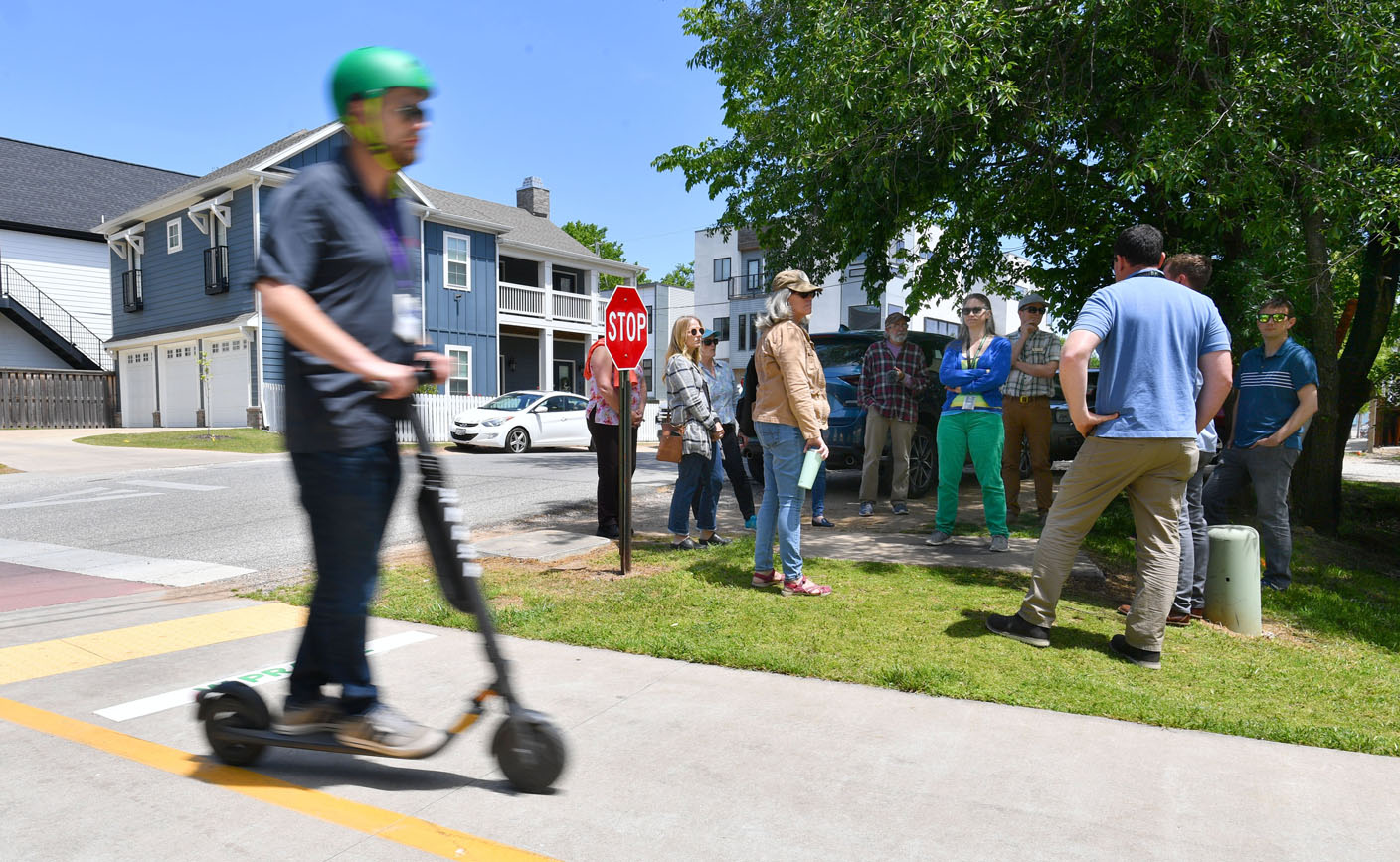 A resident on an electric scooter rides past Wednesday, May 3, 2023, as a group of city staff and stake holders watch at the intersection of the Razorback Greenway and Prairie Street during a tour of infrastructure around Martin Luther King Jr. Boulevard and School Avenue in south Fayetteville. Toole Design Group is assisting the Northwest Arkansas Regional Vision Zero Plan with its strategy to prevent traffic deaths through the implementation of infrastructure changes following a study of the area. Visit nwaonline.com/photo for today's photo gallery. (NWA Democrat-Gazette/Andy Shupe)
A resident on an electric scooter rides past Wednesday, May 3, 2023, as a group of city staff and stake holders watch at the intersection of the Razorback Greenway and Prairie Street during a tour of infrastructure around Martin Luther King Jr. Boulevard and School Avenue in south Fayetteville. Toole Design Group is assisting the Northwest Arkansas Regional Vision Zero Plan with its strategy to prevent traffic deaths through the implementation of infrastructure changes following a study of the area. Visit nwaonline.com/photo for today's photo gallery. (NWA Democrat-Gazette/Andy Shupe)
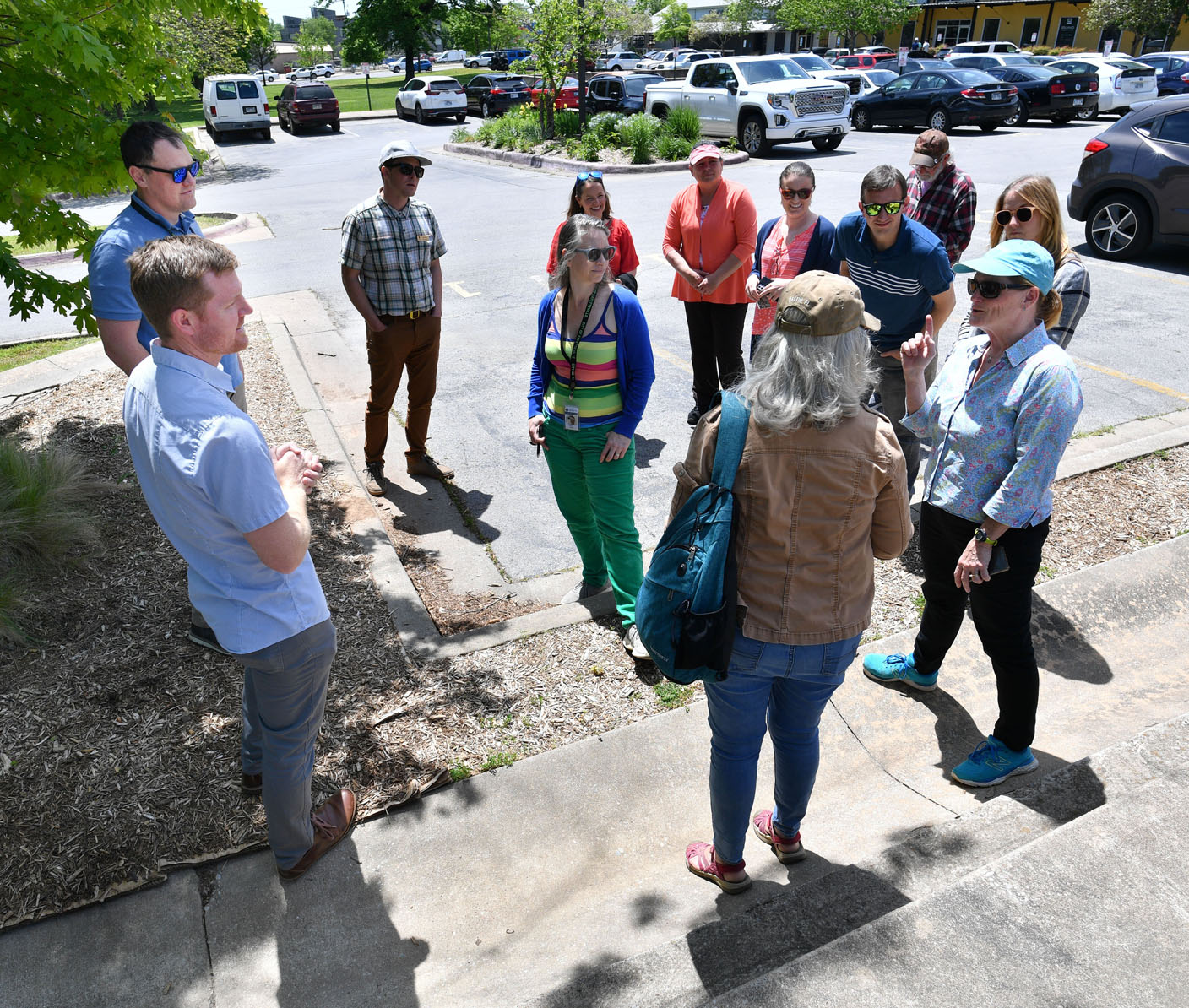 Jared Draper (left) with Toole Design Group leads a discussion Wednesday, May 3, 2023, with a large group of city staff and stakeholders during a tour of infrastructure around Martin Luther King Jr. Boulevard and School Avenue in south Fayetteville. Toole Design Group is assisting the Northwest Arkansas Regional Vision Zero Plan with its strategy to prevent traffic deaths through the implementation of infrastructure changes following a study of the area. Visit nwaonline.com/photo for today's photo gallery. (NWA Democrat-Gazette/Andy Shupe)
Jared Draper (left) with Toole Design Group leads a discussion Wednesday, May 3, 2023, with a large group of city staff and stakeholders during a tour of infrastructure around Martin Luther King Jr. Boulevard and School Avenue in south Fayetteville. Toole Design Group is assisting the Northwest Arkansas Regional Vision Zero Plan with its strategy to prevent traffic deaths through the implementation of infrastructure changes following a study of the area. Visit nwaonline.com/photo for today's photo gallery. (NWA Democrat-Gazette/Andy Shupe)
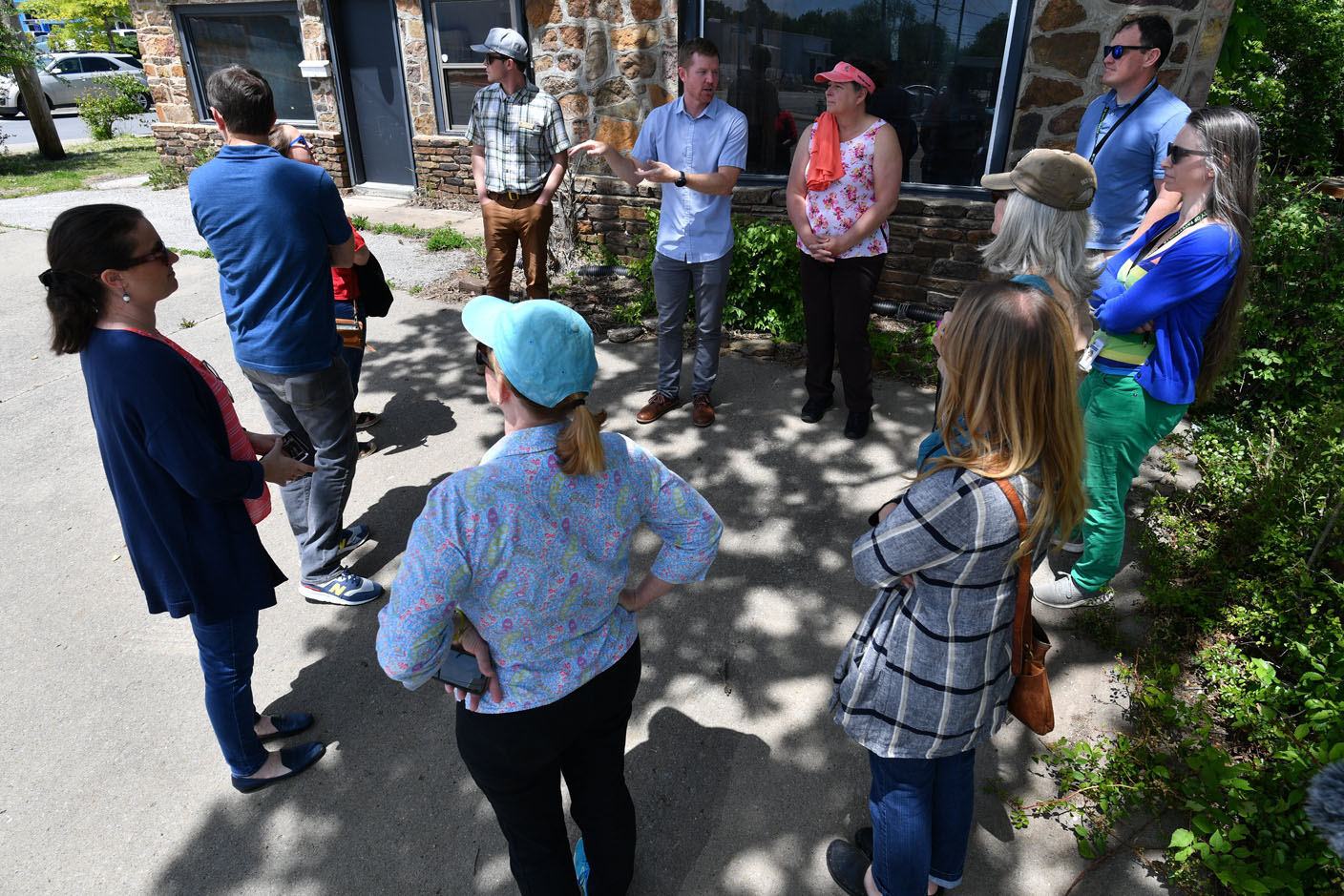 Jared Draper (center) with Toole Design Group leads a discussion Wednesday, May 3, 2023, with a large group of city staff and stakeholders at a business during a tour of infrastructure around Martin Luther King Jr. Boulevard and School Avenue in south Fayetteville. Toole Design Group is assisting the Northwest Arkansas Regional Vision Zero Plan with its strategy to prevent traffic deaths through the implementation of infrastructure changes following a study of the area. Visit nwaonline.com/photo for today's photo gallery. (NWA Democrat-Gazette/Andy Shupe)
Jared Draper (center) with Toole Design Group leads a discussion Wednesday, May 3, 2023, with a large group of city staff and stakeholders at a business during a tour of infrastructure around Martin Luther King Jr. Boulevard and School Avenue in south Fayetteville. Toole Design Group is assisting the Northwest Arkansas Regional Vision Zero Plan with its strategy to prevent traffic deaths through the implementation of infrastructure changes following a study of the area. Visit nwaonline.com/photo for today's photo gallery. (NWA Democrat-Gazette/Andy Shupe)
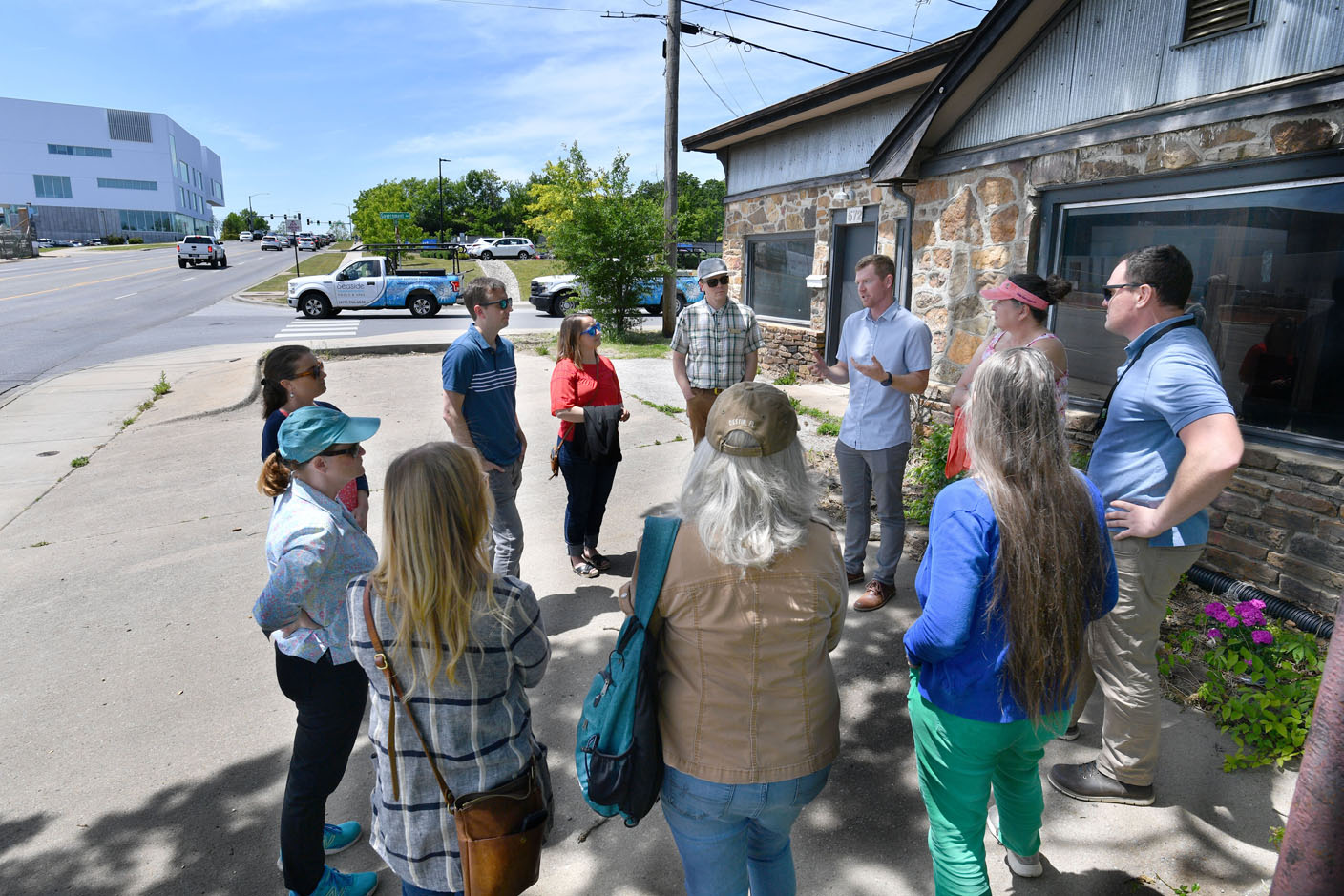 Jared Draper (center) with Toole Design Group leads a discussion Wednesday, May 3, 2023, with a large group of city staff and stakeholders at a business during a tour of infrastructure around Martin Luther King Jr. Boulevard and School Avenue in south Fayetteville. Toole Design Group is assisting the Northwest Arkansas Regional Vision Zero Plan with its strategy to prevent traffic deaths through the implementation of infrastructure changes following a study of the area. Visit nwaonline.com/photo for today's photo gallery. (NWA Democrat-Gazette/Andy Shupe)
Jared Draper (center) with Toole Design Group leads a discussion Wednesday, May 3, 2023, with a large group of city staff and stakeholders at a business during a tour of infrastructure around Martin Luther King Jr. Boulevard and School Avenue in south Fayetteville. Toole Design Group is assisting the Northwest Arkansas Regional Vision Zero Plan with its strategy to prevent traffic deaths through the implementation of infrastructure changes following a study of the area. Visit nwaonline.com/photo for today's photo gallery. (NWA Democrat-Gazette/Andy Shupe)
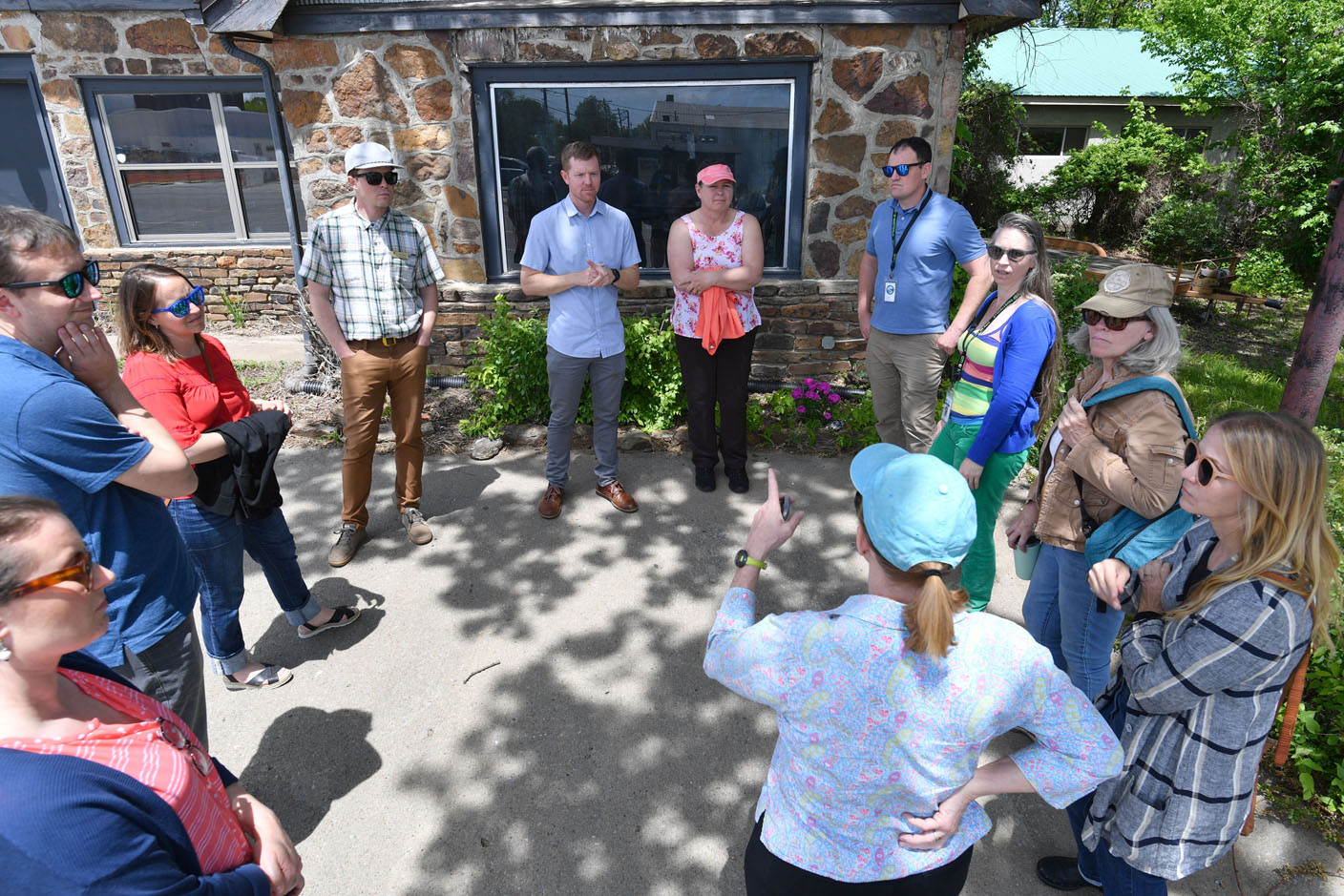 Jared Draper (center) with Toole Design Group leads a discussion Wednesday, May 3, 2023, with a large group of city staff and stakeholders at a business during a tour of infrastructure around Martin Luther King Jr. Boulevard and School Avenue in south Fayetteville. Toole Design Group is assisting the Northwest Arkansas Regional Vision Zero Plan with its strategy to prevent traffic deaths through the implementation of infrastructure changes following a study of the area. Visit nwaonline.com/photo for today's photo gallery. (NWA Democrat-Gazette/Andy Shupe)
Jared Draper (center) with Toole Design Group leads a discussion Wednesday, May 3, 2023, with a large group of city staff and stakeholders at a business during a tour of infrastructure around Martin Luther King Jr. Boulevard and School Avenue in south Fayetteville. Toole Design Group is assisting the Northwest Arkansas Regional Vision Zero Plan with its strategy to prevent traffic deaths through the implementation of infrastructure changes following a study of the area. Visit nwaonline.com/photo for today's photo gallery. (NWA Democrat-Gazette/Andy Shupe)

